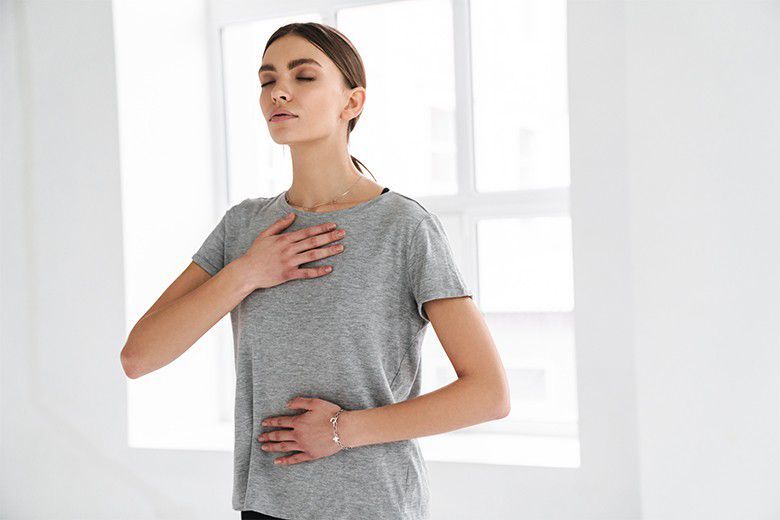Respiratory physiotherapy

- 1 Importance of respiratory physiotherapy
- 2 Exercises
What is respiratory physiotherapy?
Respiratory physiotherapy includes exercises and techniques designed to make breathing easier for the patient and promote conscious awareness of the body while breathing.
It is a specialisation of physiotherapy and is used, for example, in patients with asthma, chronic obstructive pulmonary disease (COPD) or, currently on Long-Covid patients.
Respiratory physiotherapy or respiratory gymnastics is an area of physiotherapy that aims to make breathing easier for a patient through various techniques, e.g., by strengthening respiratory muscles or adopting a specific posture.
For correct or better breathing, the patient must be involved and improve their body awareness during breathing. For example, even in pre-natal courses, expectant mothers are taught to use respiratory physiotherapy exercises during childbirth.
Importance of respiratory physiotherapy
The disorders that make respiratory physiotherapy necessary are sudden or permanent shortness of breath, sputum production, coughing, and respiratory dysfunction.
Such problems occur, for example, in pathologies such as:
-Chronic obstructive bronchitis
-COPD (chronic obstructive pulmonary disease)
-asthma
-inflammation of the lungs (pneumonia)
-pulmonary fibrosis
-cystic fibrosis (mucoviscidosis)
-surgery or trauma to the chest area
-paraplegia and incomplete quadriplegia
-multiple sclerosis and amyotrophic lateral sclerosis
It is generally necessary and helpful if a person has to be ventilated artificially (for a long time) or if lung function is still limited after an acute phase of the disease, as with Long-Covid, after Covid-19.
What does respiratory physiotherapy do?
The specialised physiotherapist decides which methods are suitable, necessary and useful in each case, depending on the therapeutic goals and the patient’s condition. All exercises are first described and possibly demonstrated by the therapist.
The patient imitates the exercise, with the therapist providing support if necessary. If the training leads to the onset of pain in a movement during respiratory therapy, it can also be performed in a reduced manner.
Respiratory physiotherapy uses exercises to:
-improve the patient’s thoracic and spinal mobility,
-directly improve voluntary and involuntary respiratory movement,
-regulate the breathing rhythm,
-strengthen the breathing muscles,
-unclog and widen the airways,
-relaxation,
-emergency intervention.
Respiratory physiotherapy: exercises
Physiotherapists often use so-called stretching and twisting positions to improve mobility.
1. The patient lies supine on a mat and concentrates on body parts directly on the mat, e.g., the back o r buttocks. Then they should relax completely and consciously ‘let themselves sink in.’ Then the therapist directs the ‘lower rotation position’: the patient lifts their knees with their feet touching and lets their knees drop to the side.
They put their arms in a U-shape above their head and turn their head in the opposite direction of their legs.
Now the legs are alternately inclined to the right and left, so that the torso is stretched in the direction of the longitudinal axis of the thighs.
2. Another example of an exercise is the so-called quadruped stand: the patient stands on all fours on the floor (knees directly under the hip joints, hands directly under the shoulders). They start by hunching over like a cat, i.e., bending the spine upwards and lowering the chin towards the chest.
Then follows the countermovement: the patient slowly and consciously presses the sternum down and thus arches the back. The head is slightly hyperextended backwards. This can be repeated several times.
3. A possible variation of the previous exercise is not to place the hands under the shoulders but to place the fingertips on the floor directly in front of the supported knees to specifically train the thoracic area of the spine during back bends and stretches.
4. Another variation consists of not placing the palms of the hands on the floor but the forearms under the shoulders. This exercise mainly trains the lumbar spine.
Respiratory physiotherapy: exercises to improve respiratory movement
The therapist helps the patient consciously perceive their respiratory movement to promote respiratory activity. On the other hand, the patient actively trains the respiratory movement during inhalation:
-repeated “sniffing” during inhalation,
-slow and deep inhalation and shortness of breath
-plugging a nostril during inhalation through the nose
Breathing exercises can positively influence exhalation: it helps a lot, for example, to make exhalation visible by breathing against a mirror.
While exhalation is passively supported by so-called manual chest compression:
-the patient lies supine on a therapy couch with legs spread to the side.
The therapist places their hands on the chest and squeezes it gently but firmly while exhaling. The patient should feel the pressure but not find it tiring or restrictive.
Respiratory physiotherapy: exercises for a regulated respiratory rhythm
Stretching exercises can serve to regulate breathing as well as breathing helps the stretching itself.
During stretching exercises, which should usually be performed in any type of sport, it is useful to maintain a breathing rhythm in which the breath does not have to be held during any phase of the exercise. Indeed, it is possible and useful to perform the stretching phase during an inhalation and the release phase during an exhalation.
Passive stretching exercises with the therapist are also possible:
-the patient lies on his or her side on a therapy couch and bends the lower leg. The upper part is placed lying on a support pad.
The therapist grasps the inside of the knee with one hand and the ankle with the other.
While the patient inhales, the therapist stretches the calf muscles (the patient must remain completely relaxed). While exhaling, he/she performs the release phase. Arms, feet or hands can also be treated in this way.
Respiratory physiotherapy: exercises to strengthen the respiratory muscles
To strengthen the muscle groups involved in inhalation, the patient lies prone. The pressure of the abdominal organs on the diaphragm makes breathing more difficult and requires more work in order to breathe deeply.
To facilitate exhalation, it is recommended to perform light abdominal muscle exercises such as sit-ups or simply stretching the abdominal muscles while standing.
Respiratory physiotherapy: exercises to unblock and widen the airways
In cases of pneumonia or cystic fibrosis, mucus and secretions collect in the airways and obstruct them. Respiratory therapy can help with various mucolytic exercises.
-an example is humming ‘M’ while exhaling or expelling air with the sounds ‘P, T, K’ so that the chest vibrates and the mucus is loosened.
-firmly tapping the back of the affected area of the lungs with your fingers has the same mucolytic effect as vibration.
To keep the airways wide open and thus allow good gas exchange, a body position that facilitates breathing is often sufficient:
-Lateral position with torso slightly elevated
-Sitting with arms leaning back
-Standing with arms resting on an object (e.g. a table) or a wall
-‘Goalkeeper’s stance’ (standing with hands on thighs)
-‘Coach Seat’ (seated, torso forward, arms resting on thighs)
Respiratory physiotherapy: relaxation exercises
-To relax and slow down breathing, the patient lies on his back and rests his hands on his stomach. While breathing, gently stroke his abdominal wall with your hands. The same also works when sitting, here the hands should rest on the ribs. He can easily perform this technique alone.
-Therapeutically guided exercises are, for example, shaking.
The therapist grabs the patient’s arm and lifts it into a relaxed position. He then repeatedly pulls it gently and lets it go again.
Reflexive Respiratory Physiotherapy
In so-called reflexive respiratory therapy, the therapist uses the body’s reaction to breathing exercises.
The holistic therapy consists of four parts:
1. Application of intense heat
2. Manual treatment
3. Breathing training
4. Therapeutic postures
First, the therapist wraps the arms or legs in warm towels. In this way, the muscles are relaxed and prepared for manual therapy and blood circulation and breathing are stimulated.
This is followed by special physiotherapeutic holds, which, similar to a massage, aim to stretch the muscles and loosen the connective tissue.
This is followed by respiratory therapy exercises.
Respiratory therapy: exercises for emergencies
To counteract the collapse of the bronchi during an asthma attack, patients learn the so-called half-open lips during respiratory therapy: during an asthma attack, they exhale against their contracted and slightly open mouth. As a result, the exhaled air is trapped in the lungs and keeps the bronchi open through pressure.
Risks of respiratory physiotherapy
Respiratory physiotherapy is a safe procedure when performed by a qualified therapist, but if applied improperly, on the other hand, it can lead to health problems: for example, abnormally deep and rapid breathing (hyperventilation) can lead to insufficient oxygen supply, the consequences of which are muscle cramps, sensory disturbances, chest pain and dizziness.









